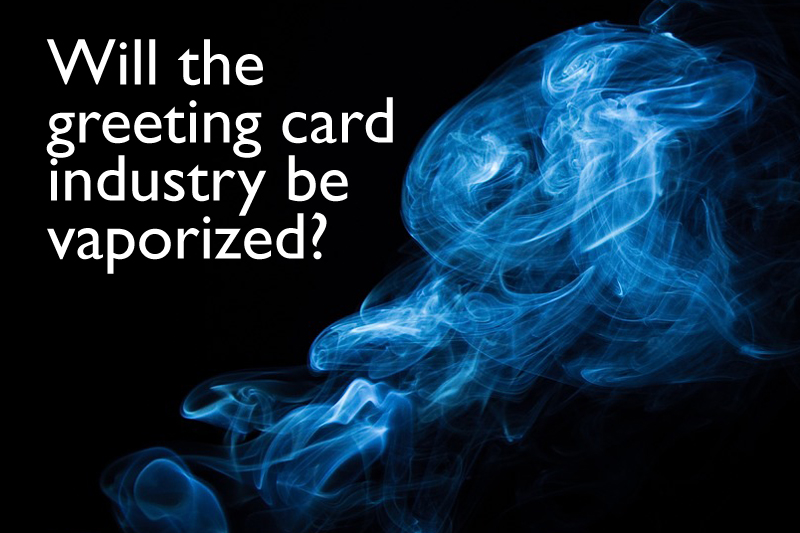 I recently attended a masterful talk by Robert Tercek, author of Vaporized, on the subject of disruption in business. It was startling to hear example after example of industries being displaced by a new dematerialised world. Robert believes that every aspect of our economy and society is set to be reconfigured by technological forces that only a small number of companies have yet mastered.
I recently attended a masterful talk by Robert Tercek, author of Vaporized, on the subject of disruption in business. It was startling to hear example after example of industries being displaced by a new dematerialised world. Robert believes that every aspect of our economy and society is set to be reconfigured by technological forces that only a small number of companies have yet mastered.
It often seems obvious in hindsight when companies disrupt markets and yet we seldom see it coming. The most recent examples in the greeting card business have been Card Factory and Moonpig. The former disrupting the wholesale space through a vertically integrated model that offers consumers rock bottom prices in well presented retail environments. The latter disrupting through the digital substitution of bricks and mortar retail space by offering extensive choice and customisation that cannot be matched by traditional retail. Both have been rewarded with incredible growth and financial success by offering value to consumers.
Yet these companies haven't really revolutionised the greeting card market. They’ve brought business models from other industries into the card business and forever changed aspects of it. They haven't vaporized our industry. In fact, I believe that they’ve kept the wolf from the door. By offering low cost cards, Card Factory has helped people to continue sending cards when they might otherwise have abandoned them in order to save money during the recession. Similarly, Moonpig has allowed men and people who are short on time to use a more efficient process to stay connected with their loved ones through cards. The card industry has yet to be vaporized.
Or will it?
In sci-fi movies there are plenty of representations of futures where greeting cards don’t exist. It’s not hard to imagine a future without greeting cards. Having said that, there is one vision of the future that does incorporate the handwritten letter. It’s the delightful movie ‘Her’ by Spike Jonze. In it the protagonist works for a company called BeautifulHandWrittenLetters.com The sentiment is still created by humans and the letters are printed out in fonts that look handwritten.
‘Her’ is a clever re-imagining of the future that recognises our innate human need for nostalgia. Nostalgia is an idealised past. It relates to an emotional state that we place into a specific time frame. As long as we keep sending cards there will always be an element of this nostalgic element in our lives.
That’s what my YouTube channel, The Greeting Card Project, is all about: Acknowledging the special importance of hand writing cards. Remembering to think of others and reminding them that they are in your thoughts. Although, I’m halfway through my project and I can tell you first hand that card sending is incredibly inefficient. As such, it is a target for being vaporized. I know because I’ve sent around 100 different cards to people in the last six months.
This is because, to send a card...
You have to remember the birthday or occasion required for card sending. This takes time and organisation. You often need to track down the recipient’s current address, then record it correctly for accurate delivery. You need to have postage stamps or be prepared to weigh and send at the post office, especially if the card is to go abroad. Stamps aren’t cheap either. Even if you are delivering it by hand you need to remember it and deliver on time.
You then have to choose a card that’s suitable for the recipient. This can take time and you might not always be able to find the right card in the first shop you visit. Recently I went to one store to buy a fiftieth birthday card for a customer of mine. Despite six options, none were suitable. I had to compromise with a decent generic birthday card rather than a poor occasion specific design. Not ideal.
Once you have the card, you have to think about what to write in it. For some people this can feel like hard work. Given how seldom we need to write these days, you might even have to remember how to write by hand! You need to write the card carefully so as to avoid mistakes. If you mess it up you might have to buy another card and start again in order to avoid looking like a child that can’t spell… or write.
After this you have to get it to a post box that collects on time. A lot of post boxes are now emptied at 9am, so you can’t leave it too late. Frustratingly, Royal Mail don’t share post box information online so you have to visit the post box for up to date info. Royal Mail also don’t offer many later collections. In Brighton & Hove the whole town has to travel up to 3 miles into the centre to reach the single post box that collects at 7pm!
Finally, you have to rely on Royal Mail to deliver the card on time. Out of the 100 cards I’ve sent this year so far, there are at least two, that I know of, that never arrived. Admittedly the postal service in the UK is superior to some other countries I’ve visited. Of the three cards I sent from Italy in my Milan episode, the first took a week to arrive within Italy, the next took 3-4 weeks to reach Wales and the last took 6 weeks to reach Los Angeles.
And yet…
It is the very inefficiency of the process that makes receiving a card so special. That and the fact that all we tend to receive through the letter box these days is junk mail, bills and bank statements. It is deeply personal receiving a handwritten letter. It’s a wonderful gift from a close friend and a delightful surprise from anyone else. For anyone that recognises the importance and value of close personal relationships for business or pleasure, it is still a powerful tool to send a card a or handwritten note.
Stephen Kelly, the CEO of software company Sage, agreed with this when explaining to me why he uses Blue Eyed Sun cards to send to friends, family and colleagues:
“It’s so powerful if one of our colleagues opens a card and I’ve personally written that card. It takes time, it shows love, it shows dedication. We love social media, but sometimes it’s really important to show that touch that is very personal and you can only get through a card.” - Stephen Kelly, CEO Sage
Whether or not the card industry will be vaporized is still up for question. Time will tell. Let's not wait for it to happen and keep fighting to maintain and support this wonderful tradition that offers such a powerful way of connecting despite of, and perhaps because of, its inefficiency.
So what can we do? Two things:
1. Send more cards
So many of us in our industry don’t do this enough. Send cards every week. Tweet about it, Instagram it. Most of us in the industry have access to excess stock in our warehouses and shops. Make these available to your staff and encourage them to send cards too. Share your card sending stories on social media. Most importantly, send cards to young people and kids. In years to come they will have that wonderful feeling of nostalgia for greeting cards and want to share it.
2. Support card sending
A great example of a retailer initiative is Feel Good Friday from the Postmark stores in London. They offer a free card from a special box of clearance stock on special Fridays. As long as you write it in the store there and then, they’ll even post it for you.
Other great initiatives include:
#JustACard campaign each week on social media
#NatStatWeek in April
#ThinkingOfYouWeek in September
#FestiveFriday early December each year
Involve your team by giving them an hour to write as many cards as they like and pay for the postage. Involve your card loving friends by giving them small gift packs of cards to send. Get others sending more cards. We are all helping to spread more love in the world by doing this and supporting our beloved card industry.
Last, but not least, be sure to watch, like and share The Greeting Card Project videos - www.youtube.com/thegreetingcardproject
Read more:
Five ways to improve your retail business
Seven habits of highly effective retailers
Watch Robert's talk below:
THE RISE OF DIGITAL SERVICES: Robert Tercek's keynote speech at Sage Summit 2017 from Robert Tercek on Vimeo.













